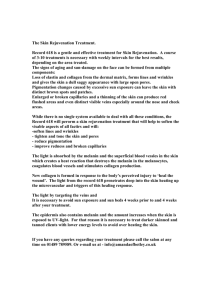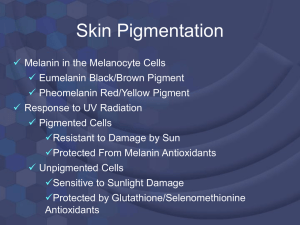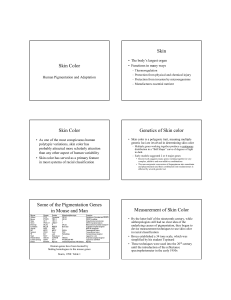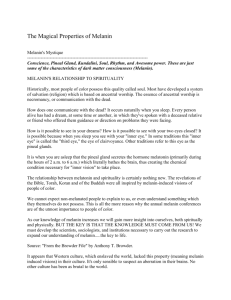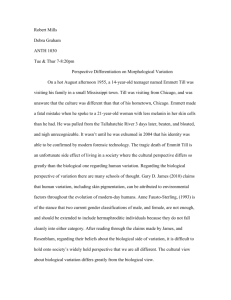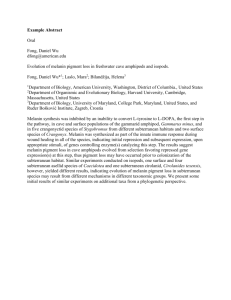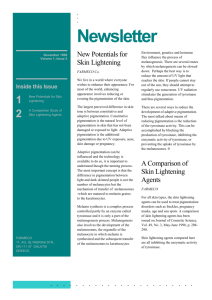Skin Color - Anthropology
advertisement
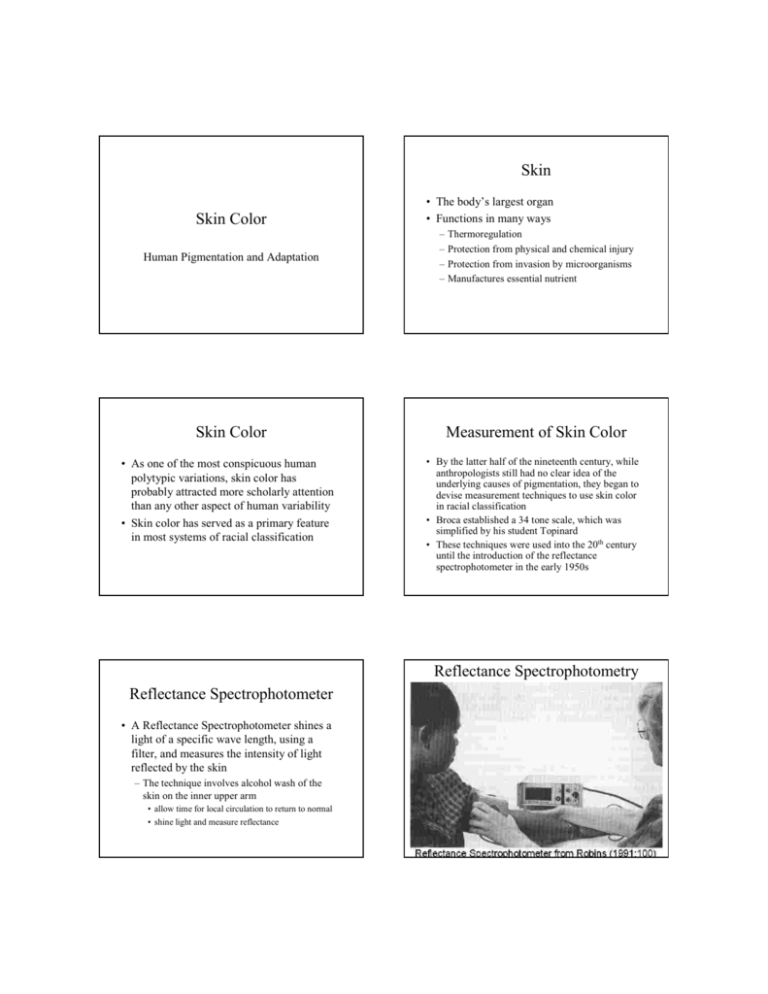
Skin
Skin Color
•Thebo
dy
’
sl
a
r
g
e
s
to
r
g
a
n
•Functions in many ways
Human Pigmentation and Adaptation
–Thermoregulation
–Protection from physical and chemical injury
–Protection from invasion by microorganisms
–Manufactures essential nutrient
Skin Color
Measurement of Skin Color
•As one of the most conspicuous human
polytypic variations, skin color has
probably attracted more scholarly attention
than any other aspect of human variability
•Skin color has served as a primary feature
in most systems of racial classification
•By the latter half of the nineteenth century, while
anthropologists still had no clear idea of the
underlying causes of pigmentation, they began to
devise measurement techniques to use skin color
in racial classification
•Broca established a 34 tone scale, which was
simplified by his student Topinard
•These techniques were used into the 20th century
until the introduction of the reflectance
spectrophotometer in the early 1950s
Reflectance Spectrophotometry
Reflectance Spectrophotometer
•A Reflectance Spectrophotometer shines a
light of a specific wave length, using a
filter, and measures the intensity of light
reflected by the skin
–The technique involves alcohol wash of the
skin on the inner upper arm
•allow time for local circulation to return to normal
•shine light and measure reflectance
Skin color is Continuous:
Mean (dot) and s.d. (bar) of skin
color, for 22 populations
Biological Determinants
of Skin Color
•The pigments Carotene,
Carotene Hemoglobin,
Hemoglobin and
Melanin are involved in skin color
•Carotene, the least common skin pigment
results in a yellowing of skin
–Results primarily from the over-consumption of
carotene containing foods (like carrots)
–This pigment is significant almost exclusively
in pathological or abnormal skin coloration
Hemoglobin
Structure of the Epidermis
Melanocytes and Skin Color
Eu
ro p
e an
s
Asian
–Produces the bluish tint to lightly pigmented skin that is
characteristic of oxygen deprivation and suffocation
Native American
–Produces a pinkish tint to lightly pigmented skin
•Deoxygenated hemoglobin has a purplish color
Solomon Islanders
•Oxygenated hemoglobin has a reddish hue
•The primary determinant of variability in
human skin color is the amount, density,
and distribution of the pigment melanin
•Melanin has a dark brown/purple/black
color that is intensified by denser
compaction of the melanin granules in the
cells of the upper layers of the skin
African American
–It is the primary protein constituent of Red Blood
Cells
Melanin
Australian Aborigine
•Hemoglobin is the complex molecule
responsible for transport of oxygen throughout
our bodies
Layers of the Epidermis
Layers of the Epidermis
•The stratum granulosum consists of several
layers of flattened polyhedral cells with
their long axis parallel to the skin surface
•The stratum basale consists of columnar cells, the
keratinocytes with about 10% of the cells
comprising melanocytes
–This is the germinal level of the skin which gives rise to
the outer layers of cells and the melanin granules that
pigment them
–Cytoplasm contains keratohylin
–As the cells increase in size they die out
•The stratum corneum is composed of a
varying number of layers of dead
keratinized cells fused to one another except
for the outer edge where flaking takes place
•This is also where 90% of Vitamin D synthesis takes place
•The stratum spinosum consists of several layers
of irregular polyhedral cells (keratinocytes)
flattened on their edges
Melanin Metabolism
Melanocytes synthesize melanin which is combined into
granules and injected into the surrounding keratinocytes
Tyrosinase
Tyrosine
Tyrosinase
Dopa
Dopaquinone
= contributes to
copolymerization
Leucodopachrome
5,6-Dihydroxyindole2-carboxylic acid
5-S-Cysteinyldopa
Dopachrome
5-S-Cysteinyldopaquinone
5,6-Dihydroxyindole
Benzothiazine
Intermediaries
Indole-5,
6-quinone
Eumelanin
+protein
Eumelanosome
Phaeomelanosome protein+ Phaeomelanin
DOPA (path to melanin)
In dark skin, melanosomes accumulate
eumelanin and remain as single particles,
while in lighter skins they contain increasing
amounts of phaeomelanin and cluster in
membrane bound organelles, lysosomes
Tyrosinase
Diet
P-hydroxyphenylpyruvic oxidase
Hydroxyphenylpyruvic Acid
5%
Phenylalanine
pathways
Thyroxine
Tyrosine
Diet
Iodination of tyrosine is the precursor
95%
Phenylalanine
Tyrosine
hydroxylase
Phenylalanine
hydroxylase
DOPA
(dihydroxyphenylalanine)
Phenylpyruvic acid
Dopamine
• Neuromelanin reduces
Noradrenaline
Adrenaline
Neuromelanin
oxidative damage via the
inactivation of damaging
free radicals
• Neuromelanin also plays
a role in iron chelation
Melanin Metabolism
Phenylalanine Metabolism
• Pleiotropy: A situation whereby several seemingly unrelated
phenotypic effects are Influenced by the action of a single gene
– Phenylalanine hydroxylase insufficiency causes phyenlketonuria: PKU
• Growth retardation (small body, small head size), mental retardation (mean IQ
between 20-30), light hair and skin
Tyrosinase
Tyrosine
Dopa
Leucodopachrome
5,6-Dihydroxyindole2-carboxylic acid
5-S-Cysteinyldopa
Dopachrome
5-S-Cysteinyldopaquinone
• Can have reproductive implications including enhanced or reduced fertility
depending on mating preferences.
– P-hydroxyphenylpyruvic oxidase deficiency causes tyrosinosis
5,6-Dihydroxyindole
• Increased levels of circulating tyrosine and tyrosine metabolites
• Does not abnormally increase synthesis of melanin
• Similar to iodine deficiency disease, but not treatable by diet
+protein
Melanin Synthesis
Eumelanosome
Phaeomelanosome protein+ Phaeomelanin
Tyrosinase inhibition
Dopa
–Starts with the amino acid tyrosine oxidized by the
copper-containing enzyme tyrosinase to
dihydroxyphenylalanine (dopa) and then to dopaquinone
Tyrosinase
–In the extreme, this produces a genetic form of albinism
Tyrosine
GSH
Inhibit (Reduced
Glutathione)
Glutathione
Reductase
•A mutation to the gene for the enzyme tyrosinase that produces a
protein with decreased functionality will result in a reduced
production of melanin
Benzothiazine
Intermediaries
Indole-5,
6-quinone
Eumelanin
•The metabolic pathway to melanin is extremely
complicated, involving several intermediate steps
Dopaquinone
= contributes to
copolymerization
– Tyrosinase deficiency causes albinism
– Deficient enzymes in the Iodination of tyrosine on this pathway causes
hereditary cretinism
Tyrosinase
GSSG
(Oxidized
Glutathione)
• Tyrosinase activity is
inhibited by a number of
compounds including reduced
glutathione (see G-6-P D
notes)
– In the skin, the enzyme
glutathione reductase (GR) is
responsible for producing GSH
– Africans tend to have lower
levels of GSH and GR
•Of the 3 GR variants, Africans
tend to have the least efficient
form
– Lower GSH levels lead to
greater melanin synthesis
Melanin Synthesis, 2
–Dopaquinone undergoes a series of non-enzymatic
reactions and rearrangements forming the different
molecules that are co-polymerized to make up one of the
types of melanin
•Eumelanin is the dark brown/purple/black compound found in
skin and hair
•Phaeomelanin is the yellow-to-reddish-brown pigment which is
present in red hair resulting from the addition of the amino acid
cystine
–Both forms of melanin combine with other proteins to
form the melanosome that is distributed from the
melanocyte to surrounding cells
Genetics of Skin color
•Skin color is a polygenic trait, meaning multiple
genetic loci are involved in determining skin color
–Multiple genes working together produce a continuous
di
s
t
r
i
b
ut
i
o
ni
na“
Be
l
lSha
pe
”c
ur
v
eo
fde
g
r
e
e
so
fl
i
g
ht
to dark.
–Early models suggested 2 or 4 major genes
•Recent work suggests many genes working together in very
complex, additive and non-additive combinations
•The non-enzymatic conversion of dopaquinone into eumelanin
and phaeomelanin and their combination into melanosomes is
affected by several genetic loci
Pigmentation Genes
Tanning
•Tanning is a two-stage acclimatizational
response of the skin to increasing levels of
UV exposure
–Immediate tanning is the transient brownish
tan following exposure to UV-A and visible
light
•Reaches a maximum within 1-2 hours after exposure
–Fades between 3-24 hours after exposure
•No new melanosomes formed, so the likely
mechanism is the photo-oxidation of existing
melanin or other epidermal elements
UV –Tyrosinase interaction
Dopa
UV radiation
GSH needed to
oxidize free
radicals from
UV exposure
Tyrosine
GSH
Inhibit (Reduced
Glutathione)
Glutathione
Reductase
Tyrosinase
Less GSH
available to
inhibit tyrosinase
activity
GSSG
(Oxidized
Glutathione)
•Ultraviolet radiation
reduces the levels of
GSH
–Lessens the inhibition
of tyrosinase activity
–Increases the synthesis
of melanin
–Darkens the skin in
response to exposure
More Tanning
–Delayed tanning is the durable browning
caused by repeated exposure, primarily to UVB but UV-A and visible light also play a role
•Gradual process of skin darkening starting 48-72
hours after irradiation
–Reaches a maximum 19 days after an exposure
–Requires 9½ months for skin to return to original melanin
content
•Melanocytes enlarge, increase dendrite density, and
experience other internal changes
•Melanosomes increase in number and melanization
Distribution of Skin Color
Distribution of Skin Color, 2
Distribution of Skin Color, 3
•The clinal nature of skin color distribution
suggests an association with environmental
factors varying with latitude
–Ultraviolet Radiation, in particular, the quantity
of UV rays striking the surface of the earth
from the sun
–Temperature
Just-So Stories about Skin Color
•No
a
h’
sc
ur
s
eonHa
m’
ss
o
nCa
na
a
n
•Response to the heat of the sun
•Bile theory
•Aerobic theory
•Optic theory
•Pigmentation as pathology of adverse environment
•Result of disease
•Vitamin D, Folic Acid, Cold tolerance
A Biblical Account of Dark Skin Color
•Lamentations chapters 4 and 5 refer to skin color
becoming dark as a result of famine
–Ch 4, v 8: Their visage is blacker than a coal (alternate
translation: darker than blackness); they are not known
in the streets: their skin cleaveth to their bones; it is
withered, it is become like a stick.
–Ch 5, v 10: Our skin was black like an oven because of
the terrible famine (alternate translations: terrors or
storms)
Noa
h
’
sc
ur
s
eo
nHa
m’
ss
o
n
Canaan
• An early explanation of dark skin comes from
t
h
ebi
bl
i
c
a
ls
t
o
r
yo
fNoa
h’
sc
ur
s
e(
Ge
ne
s
i
s
Chapter 9, King James Version):
24. And Noah awoke from his wine, and knew what his younger
son had done unto him.
25. And he said, Cursed be Canaan; a servant of servants shall
he be unto his brethren.
26. And he said, Blessed be the LORD God of Shem; and
Canaan shall be his servant.
27. God shall enlarge Japheth, and he shall dwell in the tents of
Shem; and Canaan shall be his servant.
– Nowhere does this mention darkening of the skin,
although other sections of the bible, notably in Job
and Isaiah associate curses with darkness
Voyages of Discovery
•By the time the slave trade was actively
operating on the West African coast in the
mid to late 16th century, curiosity about the
cause of dark skin color was growing
•The accepted environmental explanation
wa
st
ha
tt
hea
c
t
i
o
no
ft
hes
un’
she
a
twa
st
h
e
cause of the differences in the complexion
of Europeans and Africans
17th Century Developments
•Accumulating evidence made it clear that the
“
he
a
to
ft
hes
u
n”e
xpl
a
na
t
i
o
nwa
snots
a
t
i
s
f
a
c
t
o
r
y
–The skin color of the aborigines of North America in
similar climates to Europeans and Africans was neither
black nor white, but olive
–Af
r
i
c
a
nswe
r
ef
o
un
dt
ov
a
r
yi
nc
o
l
o
rf
r
o
m“
bl
a
c
kt
o
y
e
l
l
o
w”a
c
c
o
r
di
ngt
os
o
u
r
c
e
so
ft
heda
y
–Africans forced into European settings were showing
no lightening of skin and those Europeans living in
Africa were not appreciably darkening
•Th
ev
i
e
we
me
r
g
e
dt
ha
tt
heAf
r
i
c
a
n’
sbl
a
c
k
ne
s
s
was innate and permanent
Thomas Browne (1605 –1682)
•This English physician published his view in his
1646 Pseudodoxia epidemica:
–“
I
ft
hefervour of the Sun, or intemperate heat of clime
did solely occasion this complexion, surely a migration
or change thereof might cause a sensible, if not a total
mutation; which notwithstanding experience will not
admit. {Despite their transplantation, there remains
among their descendants} a strong shadow of their
Originals: and if they preserve their copulations entire,
they still maintain their complexion. . . .{L}ikewise,
fair or white people translated in hotter Countries
r
e
c
e
i
v
eno
ti
mpr
e
s
s
i
o
nsa
mo
unt
i
ngt
ot
hi
sc
o
mpl
e
x
i
o
n”
–Hea
l
s
odi
s
mi
s
s
e
dt
heHa
m’
sc
u
r
s
ee
x
pl
a
na
t
i
o
na
sa
foolish tale
Biological Differences?
•Attempts made to resolve whether differences in skin
color was due to innate differences in biological structure
o
rt
r
a
ns
i
e
n
tr
e
s
po
ns
et
ot
hes
u
n’
she
a
t
–Santorio Santorio (1561-1636): 1614 De statica medicina s
ki
n
’
s
complexion was determined by the presence of black bile
•Revival of a notion from the ninth century Arabian physician
‘
Al
ia
l
-Tabari in his medical compendium Paradise of
Wisdom
–Supported by Italian anatomist Malpighi (1687)
•Determined that dermis and stratum corneum is colorless in
both Balcks and Whites, he agreed with Santorius that the
blackness of Africans must originate in the underlying
mucous and reticular body—colored by bile
•Early Eighteenth century anatomists reported the presence of
black bile in the Malpighian layer
Aerobic and Optic Theories
•Le Cat 1765 discerned black deposits he called
“
æt
hi
o
ps
”
i
nne
r
v
et
i
s
s
ue
so
fa
n
i
ma
l
s
–Without having any idea about the origin or role of
these æthiops he was convinced that there was a
relationship with the environment and he conjectured
that Negroes had more of the structures than Europeans
did, making them the basis of the dark complexion of
the Africans
•Patot 1733 claimed that complexion differences
were based on the ability of the human skin to
transmit light—t
he“
o
p
t
i
c
”t
he
o
r
yo
fs
k
i
nc
o
l
o
r
To Bile or Not To Bile
•Scholars attempting to avoid the polygenistic
implications of the bile theory clung to the work
of the French surgeon Littré who failed to find a
black gelatinous bile in the malpighian layer of
Africans
•Monogenists began advocating a more complex
view of environmental causes that harks back to
Hippocrates’Airs, Waters, Places focusing on the
differential qualities of the atmosphere
–Thi
s“
a
e
r
o
bi
c
”t
he
o
r
ywa
sc
h
a
mpi
o
ne
dbyDu Bos in
1719 and picked up by others, including Blumenbach in
his Varieties of Man in 1795
A New World Perspective
•John Mitchell (1744) published the first major
scientific study of skin color in the New World
–Compared skin of colonial Whites and African slaves in
Virginia
•Concluded there was no anatomical basis for the bile theory
•Only structural difference was thicker skin among the Africans
–Applied Newtonian optics to suggest that skin color was based
on thickness of the skin and its ability to transmit light
–As thickness increased, the skin appeared darker
•Af
r
i
c
a
n
’
st
h
i
c
ks
k
i
np
r
o
h
i
bi
t
e
dt
h
et
r
a
n
s
mi
s
s
i
o
no
fa
n
yc
o
l
o
r
through them
•He also conjectured that the original skin color of man was
neither black nor white but something in between with
Europeans and Africans represented divergent extremes caused
by the degenerative influences of the environment
Degeneration of the Primordial Type
•Buffon argued that skin color differences
were reflective of the geographical
degeneration of the primordial type
–Hes
ug
ge
s
t
sr
e
s
t
o
r
a
t
i
o
no
ft
he“
de
ge
ne
r
a
t
er
a
c
e
s
t
ot
hepu
r
i
t
ya
ndv
i
go
ro
ft
h
eo
r
i
g
i
n
a
lt
y
pe
”
would require the transplantation of the these
people to a more temperate zone plus a change
of diet and a long span of time
Pigmentation as Pathology
•Lafitau (1724) argues that dark skin color is a
congenital malformation—already present in
African fetuses
•Rush (1795) claimed the skin color of the Negro
was derived from leprosy
–He argues that Africans suffer from a congenital
disease so mild that excess pigment was the only
symptom
•Albinism and other depigmentation conditions
among Africans were seen as reversion to the
original complexion
An“
Un
i
ve
r
s
a
lFr
e
c
kl
e
”
Physiology of Pigmentation
•Samuel Stanhope Smith (1810) used the
depigmentation of Henry Moss, an African
American from Virginia to suggest that
pi
g
me
n
t
a
t
i
o
nwa
sno
t
h
i
ngmo
r
et
h
a
na
n“
u
ni
ve
r
s
a
l
f
r
e
c
k
l
e
”
,oc
c
a
s
i
o
ne
dbye
nv
i
r
o
nme
n
t
a
le
x
pos
u
r
et
o
sunlight
•He argued that climate affected skin color
•Late in the 19th century the process of
melanization in plants was discovered to be
dependent on the enzyme tyrosinase
•German histochemist Bruno Bloch demonstrated
in 1927 that this same pathway was involved in
pigmentation of human skin in vitro
•By 1950 the cells where these reactions took
place, the melanocytes, were identified and it was
found that these cells originate embryonically in
the neural crest
•By 1955 the UV protective effects of melanin in
the skin were demonstrated
–Evidence: the darkening and lightening of complexion
with the seasons
–Col
da
i
r“
c
ha
f
e
st
hec
o
unt
e
na
nc
ea
ndi
nc
r
e
a
s
e
st
he
r
u
ddi
ne
s
so
ft
hec
o
mpl
e
x
i
o
n”
20th Century Just-So Stories
•The discovery of the interaction between melanin
and UV led to a number of explanations of skin
color
•The association between vitamin D synthesis, UV
radiation, and skin pigmentation was suggested in
the 1930s but it was largely ignored until revived
by Loomis in 1967
–Loomis proposed that the rate of vitamin D synthesis is
governed by pigmentation and keratinization which
affect the amount of UV penetrating to the stratum
granulosum, making skin color responsive to UV levels
Selection Favoring Dark Skin
•Selection favoring high levels of melanin
pigmentation in areas of high Ultraviolet
(UV) radiation may involve several
selective agents
–Sunburn can cause skin lesions and infections,
preventing some degree of heat loss
–Also predisposes to skin cancer
•Highly pigmented skin provides partial protection so
selection would favor dark skins in high UV areas
Skin Cancer
–Skin cancer is found to be prevalent among
light skinned individuals in tropical latitudes
–In Nigeria and Tanzania no albino over the age
of 20 years was found to be free of malignant
or pre-malignant skin lesions
–In Tanzania chronic skin damage was found in
every albino infant by the end of the first year
of life
•This high rate and early evidence of skin damage
suggests that cancer may have been a strong
selective pressure in tropical areas
Folic Acid Deficiency
–UV light causes denaturization (a chemical
breakdown) of Folic Acid circulating in the
blood
•This can induce a deficiency even if the diet
supplies adequate folic acid
–Deficiency symptoms include anemia, infertility, and birth
defects, especially neural tube defects
•High melanin content in the epidermis can protect
circulating Folic Acid, thereby selecting for dark
skin in low latitude areas
Immune Suppression
Selection for Depigmentation
–Ultraviolet light is known to suppress immune
function
•Selection favoring low levels of melanin
pigmentation in ecosystems where there are
low levels of UV radiation (primarily in the
high latitudes) may also involve different
factors:
•It has been hypothesized that increased melanization
could protect the immune system by shielding the
blood borne components of the system from UV
•A recent study demonstrated that differences in skin
color were not associated with differences in UVinduced immune deficits
Regulation of Vitamin D
–Regulation of Vitamin D synthesis
•Vitamin D in the body is derived primarily from the
skin and secondarily from the diet
•Vitamin D is synthesized in skin by the action of
UV-B
–Precursor molecule is 7-DHC or 7-dehydrocholesterol,
which occurs in the strata granulosum and basale of the
epidermis
–UV-B exposure causes a photochemical (non-enzymatic)
conversion of 7-DHC into previtamin D
•High melanin content in skin reduces UV-B exposure
and cuts photochemical conversion
–The regulation of Vitamin D synthesis
–Frost bite sensitivity and cold tolerance
Regulation of Vitamin D, 2
–Previtamin D is transformed into vitamin D by a
temperature dependent process over 2-3 days
–Vitamin D then diffuses into the blood vessels of the
dermis
–The liver and kidney further transform the Vitamin D into
1,25-dihydroxyvitamin D which is the most active form of
the vitamin
•The function of Vitamin D is to actively cause
calcium absorption across the wall of the small
intestine into the blood stream
Regulation of Vitamin D, 4
Regulation of Vitamin D, 3
•Calcium is used for bone and tooth development as
well as for nervous and muscle action
–The skeleton serves as a calcium reservoir
–If calcium levels in intracellular fluid drops, hormones are
released to cause resorption of bone, placing calcium into
circulation
•A deficiency of Vitamin D in infants and children causes
Rickets, in adults a deficiency causes osteomalacia
–Rickets refers to a defect in the calcification of growing bone
so that the bones are structurally weak and unable to withstand
mechanical pressure
•Symptoms include muscle weakness, deformity of the long bones
including bowed legs, knuckle-like projections along the rib cage
(rachitic rosary), deformities of the pelvis that are often permanent
–Long bone deformity impairs locomotion
–Pelvic distortion can make childbearing dangerous--potentially killing
mother and baby
•Prior to widespread Vitamin D supplementation in the 1930s, Black
women in the U.S. showed nearly 8 times greater pelvic deformity than
White women
Rickets
Regulation of Vitamin D, 5
•Assuming that our ancestors had dark skin in the
tropics, as hominids moved into higher latitudes
there would have been substantial selection favoring
lower melanin content in the skin to improve
Vitamin D synthesis
Potential for synthesis of previtamin D3 in lightly
pigmented human skin based on annual average UV
Zone 1: adequate UV
radiation throughout
the year
Zone3:
not2:sufficient
UV UV
Zone
not sufficient
radiation
on average
forleast
radiation
during at
the whole
year
one month
Areas in which UV is not sufficient over the year
for lightly, moderately, and highly melanized skin
Not sufficient UV radiation,
averaged over the entire year, to
form
previtamin
D3radiation,
in lightlyaveraged over the
Not sufficient
UV
pigmented
skin
entire year,human
for moderately
pigmented human skin
Not sufficient UV radiation for
highly pigmented human skin
Predicted shading of skin colors for indigenous humans
Alternatives to skin production of
Vitamin D for Calcium Absorption
Gradation of skin colors for known
indigenous human populations
African
pastoralists
with high
reliance on
fresh milk
•Lactose appears to promote the absorption of
calcium
–Hu
ma
nmi
l
ki
s50% hi
g
he
ri
nl
a
c
t
o
s
et
ha
nc
o
w’
smi
l
k,
infants show better calcium absorption when nursing
–Milk drinking increases calcium and lactose intake,
may lessen selection on UV-Vitamin D
•Fish consumption increases intake of vitamin D
–Fish eating would decrease selection for light skin color
and biosynthesis of Vitamin D
Frost Bite and Cold Tolerance
–Frost bite sensitivity and cold tolerance
•As our ancestors moved into higher latitudes they
also would have been subject to colder temperatures
•There is a great deal of anecdotal evidence and some
medical record evidence (most from the Korean
War) suggesting that individuals with heavily
pigmented skin are more susceptible to frostbite
•Animal studies demonstrate that melanocytes are
more easily destroyed by freezing than the rest of
the skin cells
Tr
d
en
ne
Li
Lapps and
Inuit with
substantial
reliance on
fish
resources
Frost Bite and Cold Tolerance, 2
•Experiments with guinea pigs, cooling both dark and
light skinned areas on the same animal, showed dark
skin more susceptible to frost bite
•Frost bite cripples hands and feet causing survival
problems, and secondary infections including
gangrene may be fatal
Sexual Selection
•Mating preference for skin color was
promoted by Darwin as being one of the
primary reasons for differences in skin color
between the races of man
•Recently Aoki (2002) has argued that this is
the primary reason for the distribution of
aboriginal skin color
References
Aoki K. 2002. Sexual selection as a cause of human skin colour v
a
r
i
a
t
i
on:
Da
r
wi
n’
s
hypothesis revisited. Ann. Hum. Biol., 29:589-608.
Beall CM, and Steegmann T, Jr. 2000. Human adaptation to climate: temperature,
ultraviolet radiation, and altitude. In: Stinson S, Bogin B, Huss-Ashmore R,
O’
Rour
k
eD(
e
ds
.
)Huma
nBi
ol
og
y
:AnEv
ol
ut
i
o
na
r
ya
ndBi
oc
ul
t
ur
a
lPerspective.
New York: Wiley-Liss. Pp. 163-224.
Blangero J, and Williams-Blangero S (1992) Quantitative genetic analysis of skin
reflectance: a multivariate approach. Human Biology, 64:35-49.
Jablonsky NG, and G Chaplin (2000) Evolution of human skin color. Journal of Human
Evolution, 39:57–
106.
Jeevan A, and Kripke ML (1993) Ozone depletion and the immune system. The
Lancet, 342:1159-1160.
Jobling MA, Hurles ME, and Tyler-Smith C. 2004. Human Evolutionary Genetics:
Origins, Peoples, Disease. NY, NY: Garland Smith.
Montellano, BR Ortiz (1993) Melanin, Afrocentricity, and pseudoscience. Yearbook of
Physical Anthropology, 36:33-58.
Robins AH (1991) Biological perspectives on human pigmentation. Cambridge:
Cambridge University Press.
Sturm, RA (1998) Human pigmentation genes and their response to solar UV radiation.
Mutat. Res. Rev., 422:69-76.
Spencer, F (1997) Skin color. In: F Spencer (ed.), History of Physical Anthropology,
Vol. 2. Pp. 945-955.
Sexual selection and skin color
• Aoki argues that selection is unidirectional favoring dark
skin to prevent sun burn, skin cancer, folate denaturation,
etc.
– This selection would be relaxed at higher latitudes with lower UV
stress
• He suggests that there is a near universal preference for
light skin in human mate selection
– As selection lessened at higher latitudes, this intersexual selection
for lighter skin color would become a stronger force driving skin
color genes in the direction of less pigmentation
• The clinal distribution of skin color results from the
balance between natural and sexual selection
